MARIANI’S
Virtual Gourmet
March 13, 2016
NEWSLETTER
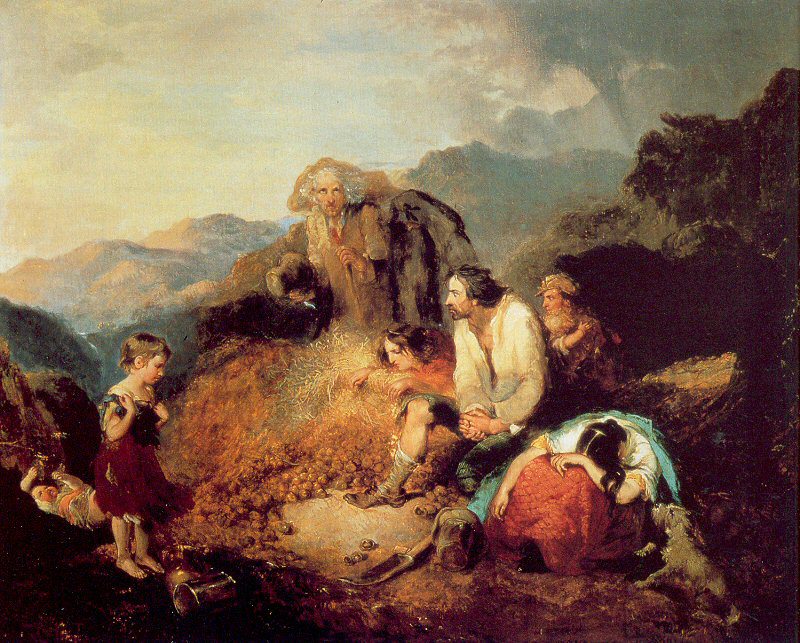
"Irish Peasant Family Discovering the Blight of their Store" by Daniel MacDonald (1847)
❖❖❖
IN THIS ISSUE
THE ALLURE OF ALSACE, Part One
By John A. Curtas
NEW YORK CORNER
THEO'S
By John Mariani
❖❖❖
THE ALLURE OF ALSACE
Part One
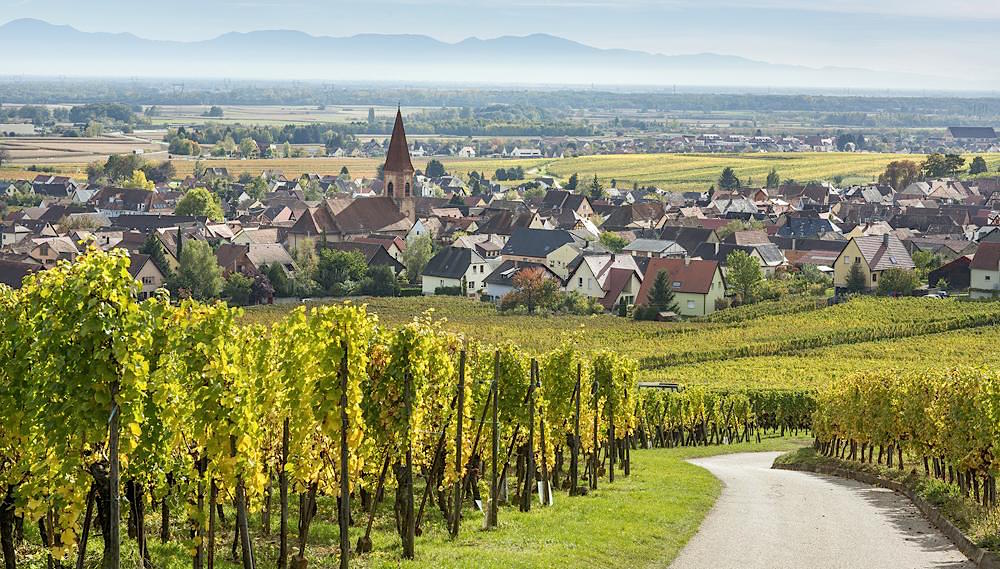
By John A. Curtas
It is impossible not to fall
in love with Alsace. Once you see it for the first
time, resistance is futile. Once you taste and drink
its many delights, stroll its cobblestone streets,
and walk among the candy-colored, half-timbered
houses, you might as well resign yourself to a
life-long love affair with Franco-German France. Alsace is a
region, but it is also a culture: a battle-born
civilization of freedoms hard won, peoples
cross-pollinated and gastronomic traditions firmly
entrenched. It also happens to be one of the most
delicious places to eat and drink on the planet.
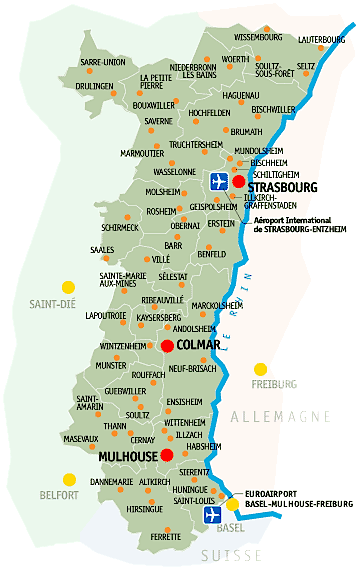 Alsace is
also a place of contradictions, and more than a
little schizophrenia. Wars have been fought for
centuries over this fertile farmland. Germany --
never a bashful sort when it comes to staking a
claim -- has always considered the Vosges Mountains
to be the natural border between it and France. The
French--by nature more accommodating--have always
maintained that the Rhine River is nature's way of
separating the two countries, and besides, they say,
we like our white wines fuller, more aromatic and
alcoholic than you do. So, to each his own choucroute.
(These differences in taste, which are taken very
seriously in these parts, have thus been the basis
for those dust-ups known as the Franco-Prussian War
of 1870, WWI and WWII, or at least that's the way I
like to think about it.)
Alsace is
also a place of contradictions, and more than a
little schizophrenia. Wars have been fought for
centuries over this fertile farmland. Germany --
never a bashful sort when it comes to staking a
claim -- has always considered the Vosges Mountains
to be the natural border between it and France. The
French--by nature more accommodating--have always
maintained that the Rhine River is nature's way of
separating the two countries, and besides, they say,
we like our white wines fuller, more aromatic and
alcoholic than you do. So, to each his own choucroute.
(These differences in taste, which are taken very
seriously in these parts, have thus been the basis
for those dust-ups known as the Franco-Prussian War
of 1870, WWI and WWII, or at least that's the way I
like to think about it.)
As a result of changing
hands -- between two countries of very different
personalities, not to mention sauerkraut -- five
times in eighty years, there is a certain split
personality in Alsace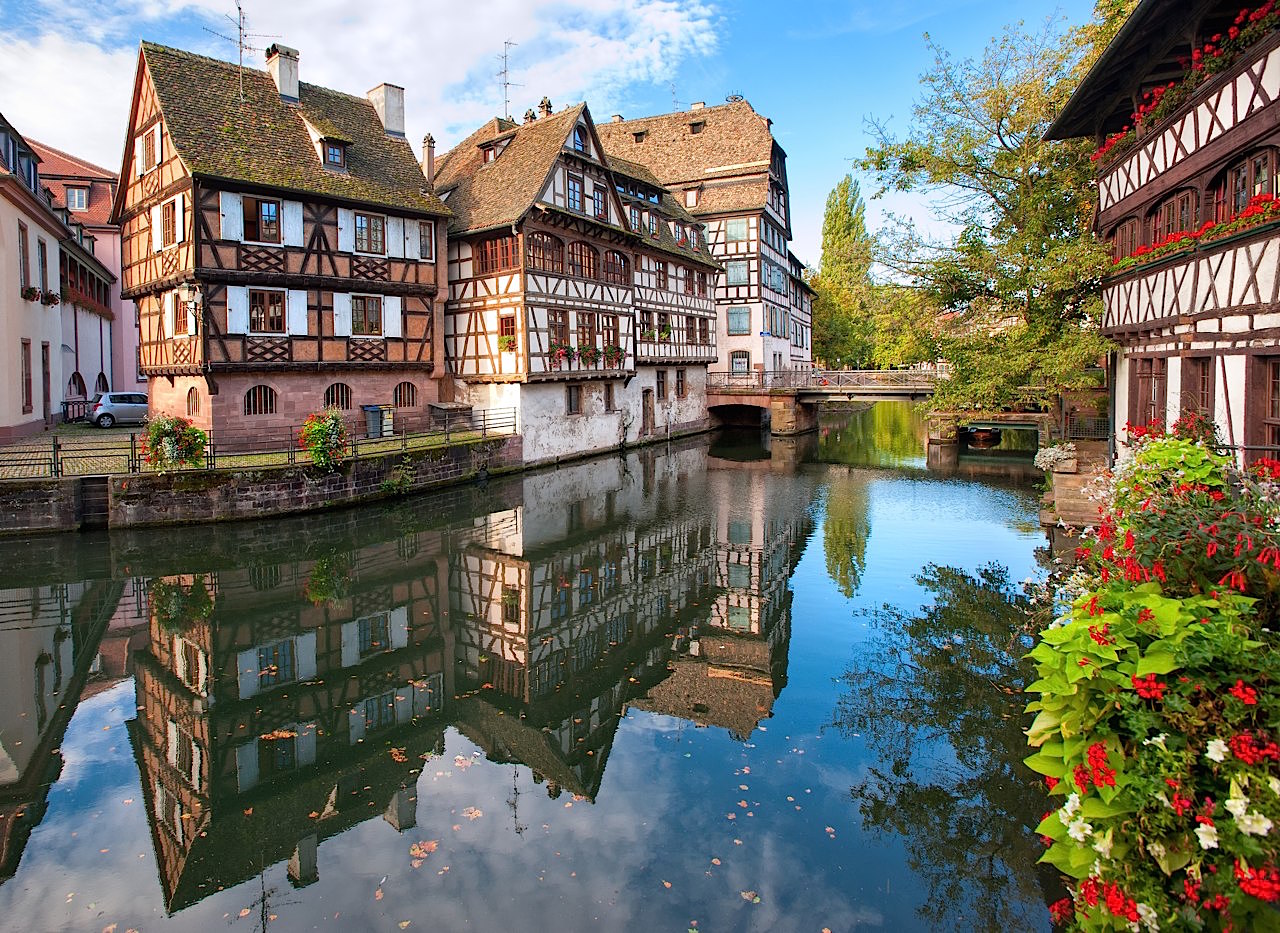 that I find
glorious. Call it Teutonic efficiency mixed with
French joie
de vivre, if you will, but never, ever make
the mistake of calling anyone there German, even
though they all have names like Klein, Becker or
Weinbach. "We are French!" they will say proudly, in
French, with a German accent, and they will scowl
(in that friendly/bemused French way) if you dare
suggest that a spätlese Riesling from the Mosel is
even in the same league as a Grand Cru Tokay Pinot
Gris. And don't even think about
comparing the charcuterie of the two countries in
polite company.
that I find
glorious. Call it Teutonic efficiency mixed with
French joie
de vivre, if you will, but never, ever make
the mistake of calling anyone there German, even
though they all have names like Klein, Becker or
Weinbach. "We are French!" they will say proudly, in
French, with a German accent, and they will scowl
(in that friendly/bemused French way) if you dare
suggest that a spätlese Riesling from the Mosel is
even in the same league as a Grand Cru Tokay Pinot
Gris. And don't even think about
comparing the charcuterie of the two countries in
polite company.
I like to think of Alsace as very, very French with
a few German accents, and from the gingerbread
architecture to the love of white wine to the
gingerbread itself, you can revel in the
similarities while enjoying the differences. All of
which you can drink in when you are strolling the
streets of Strasbourg.
You begin in Strasbourg (above, right),
of course, because it is both the capital of Alsace
and the gateway to the wine country. But this
international city is also a gastronomic gem in its
own right.
The best place to start your Alsatian education is
in the Petite France section of the old city, and
the best place to stay when doing so in Le Bouclier d'Or (left), a
four-star hotel perched right on the edge of all
sorts of 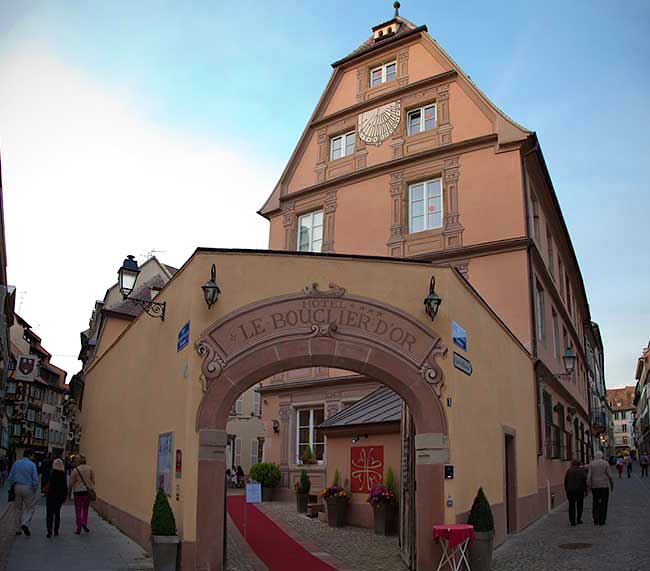 gastronomic
delights. Turn to your right as you exit and you
will find yourself right in the heart of the most
picturesque part of the city; turn a gauche
and you'll be on a street filled with shops
featuring all sorts of local delicacies, from the
great cheeses of Alsace (Tomme, Cantal and Munster)
to the local pain
d’épices, baked into giant loaves weighing as
much as a cinder block.
gastronomic
delights. Turn to your right as you exit and you
will find yourself right in the heart of the most
picturesque part of the city; turn a gauche
and you'll be on a street filled with shops
featuring all sorts of local delicacies, from the
great cheeses of Alsace (Tomme, Cantal and Munster)
to the local pain
d’épices, baked into giant loaves weighing as
much as a cinder block.
Cross the canal that circles
the old part of the city and walk a few blocks and
you'll find yourself smack dab in front Au
Pont Corbeau (below), a local favorite for its
cuisine Alsaçienne and wine list chock full of
small, local producers at gentle prices. Just like
Alsatians, we eschew the avant garde when we're
here, opting for choucroute
garni and tripes à la
mode, both of which were as soul-satisfying
and of-their-place as food can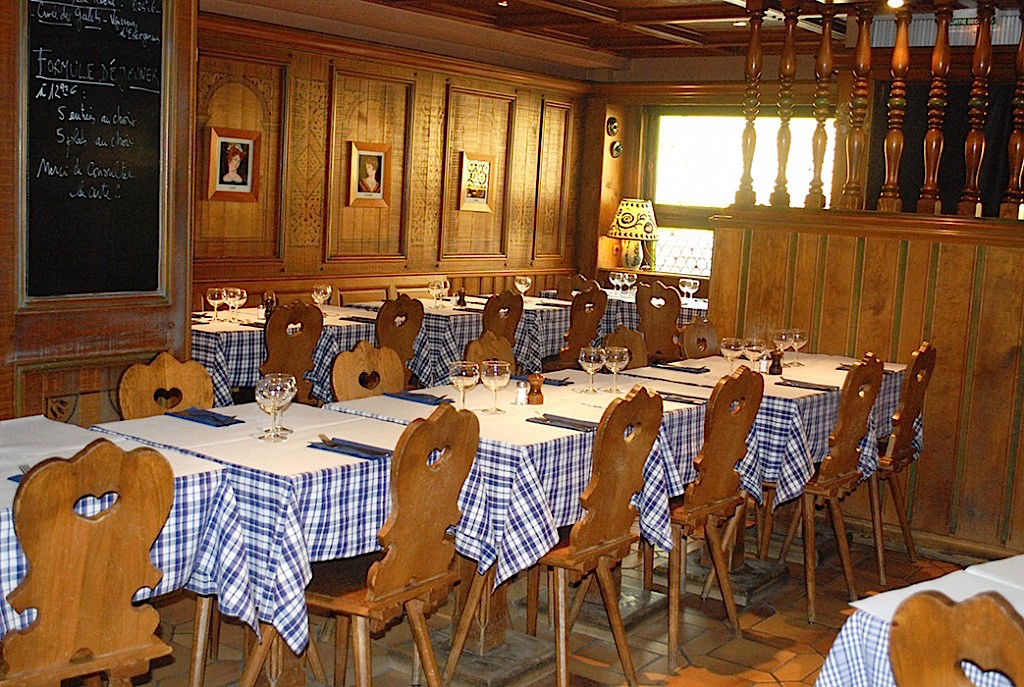 get.
(Contrary to what you might think, tripes à la
mode does not come with ice cream.)
get.
(Contrary to what you might think, tripes à la
mode does not come with ice cream.)
After lunch, it's best to walk around, do some
shopping, take in a museum, and visit the Strasbourg
Cathedral with its single spire (the tallest in the
world until 1874) and the technological marvel that
is its astronomical clock. The clock is really more
of a primitive calculating machine than a clock, but
its 60-feet height, intricate beauty and advanced,
19th Century technology make it a wonder of artistry
and engineering.
If all that sightseeing doesn't make you hungry, I
guarantee that a stroll down the Rue de Orfèvres
will. Here you will find the upscale Frick-Lutz, (below) and
various other traîteurs,
confectioners and sellers of Alsace specialties.
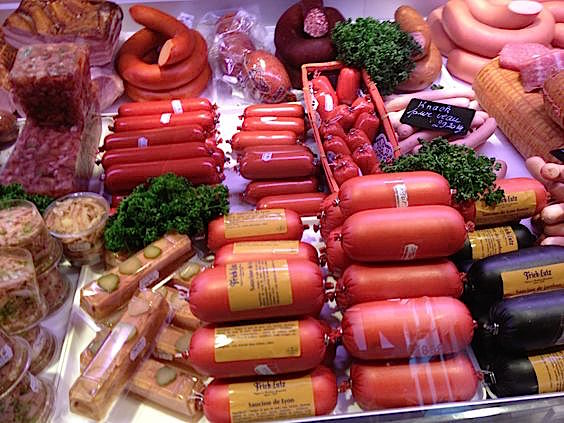
The regional delight not to
be missed is foie
d'oie, silky, delicate, almost pink-hued goose
liver, more refined than the earthier, amber-colored
duck livers you find in America, and, to my taste,
more compelling. If gazing upon a black
truffle-studded loaf of this food for the gods
doesn't make you hungry, then I suggest you retire
to the ascetic monastery whence you came.
By now it should be getting close to dinnertime. You
can pop into almost any restaurant in the Petite
France quartier
and be assured of having a good meal of local
specialties; there's even a few newer places popping
up with menus that hint of young chefs spreading
their wings, e.g.,
1741, Umami, but
traveling to Strasbourg in search of the
cutting-edge is like going to the Royal Philharmonic
for some Philip Glass. Where we like to get a
healthy dose of old Alsaçienne is at L'Ancienne Douane,
whose name literally translates to "Restaurant at
the Old Customs," located as it is in an
ancient structure that dates to 1401. Located
directly on the canal, L'Ancienne is the perfect
place to while away a summer's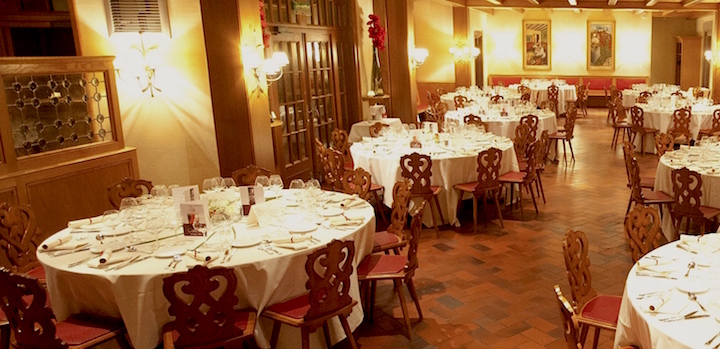 day watching the boats go by as you
tuck into hearty platters of jarret gratiné,
a
knuckle of ham with grated Munster cheese that's the
size of a small football, or a tête de veau sauce
ravigôte (veal head).
day watching the boats go by as you
tuck into hearty platters of jarret gratiné,
a
knuckle of ham with grated Munster cheese that's the
size of a small football, or a tête de veau sauce
ravigôte (veal head).
Speaking of football, the choucroute here
-- garnished as it is with six separate meats,
including two types of bacon and three different
sausages -- could stymie an NFL linebacker. In
chillier seasons, the cozy, wood-paneled dining
rooms are the perfect places to drink in the local
atmosphere and sip local wines, all served in
those gorgeous, green-stemmed glasses.
But man
does not live by choucroute alone, and a couple of
days in Strasbourg means a chance to revisit the
gastronomic institution that is Au Crocodile, a
restaurant 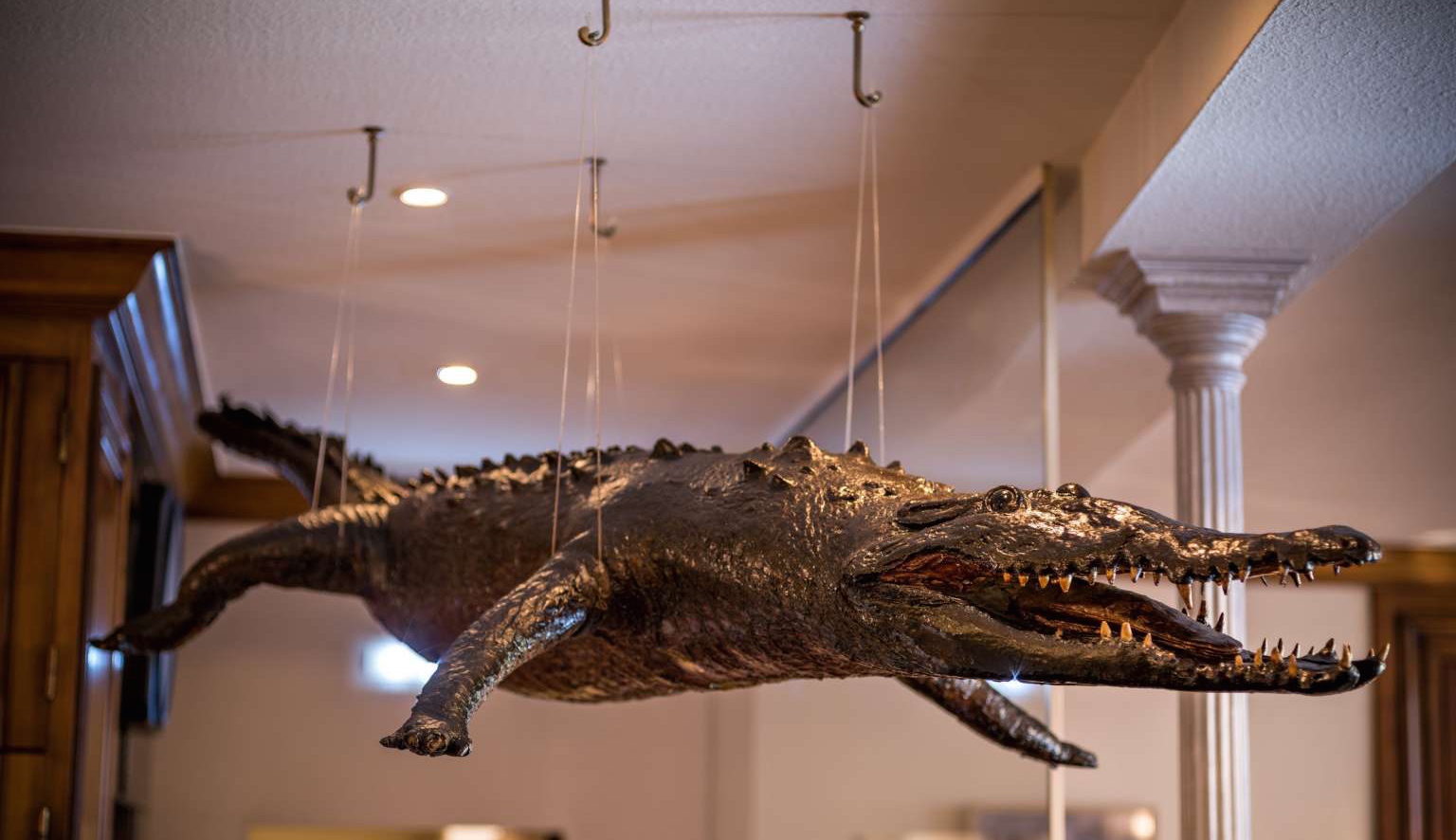 that hasn't
lost its fastball, no matter what the Michelin Guide
says. This venerable establishment held three
Michelin starts between 1989 and 2002, but no
longer holds any, much to the chagrin of former
chef/owner Emile Jung, who compared the loss of a
star to "a pain that eats at our hearts and that has
killed our spirits."
He sold the place to chef Phillipe Bohrer in
2010, and all we can hope is that Bohrer, like Alain
Senderens at Lucas-Carton in Paris and others, has
decided not to play the Michelin game anymore,
preferring instead to cook food his way, without
constant fretting over Frette linens or other
frippery -- details that must be fussed over
if the coveted stars are to be maintained.
that hasn't
lost its fastball, no matter what the Michelin Guide
says. This venerable establishment held three
Michelin starts between 1989 and 2002, but no
longer holds any, much to the chagrin of former
chef/owner Emile Jung, who compared the loss of a
star to "a pain that eats at our hearts and that has
killed our spirits."
He sold the place to chef Phillipe Bohrer in
2010, and all we can hope is that Bohrer, like Alain
Senderens at Lucas-Carton in Paris and others, has
decided not to play the Michelin game anymore,
preferring instead to cook food his way, without
constant fretting over Frette linens or other
frippery -- details that must be fussed over
if the coveted stars are to be maintained.
Michelin
inspectors are infamous for their fussiness and,
more recently, their trendiness, so Au Crocodile's
decidedly old-school charm might cost it a few
points, but there's nothing overtly stuffy about the
food or the service. The service was warm and
welcoming, and the food was à point and
all you could hope for in a fine French meal:
gorgeous foie d'oie (right),
roasted lobster with corral butter served with a
fricassée of vegetables, and a pigeon de la
ferme "Théo Kieffer" that was La Cuisine
Français in all of its subtle-yet-intense
glory.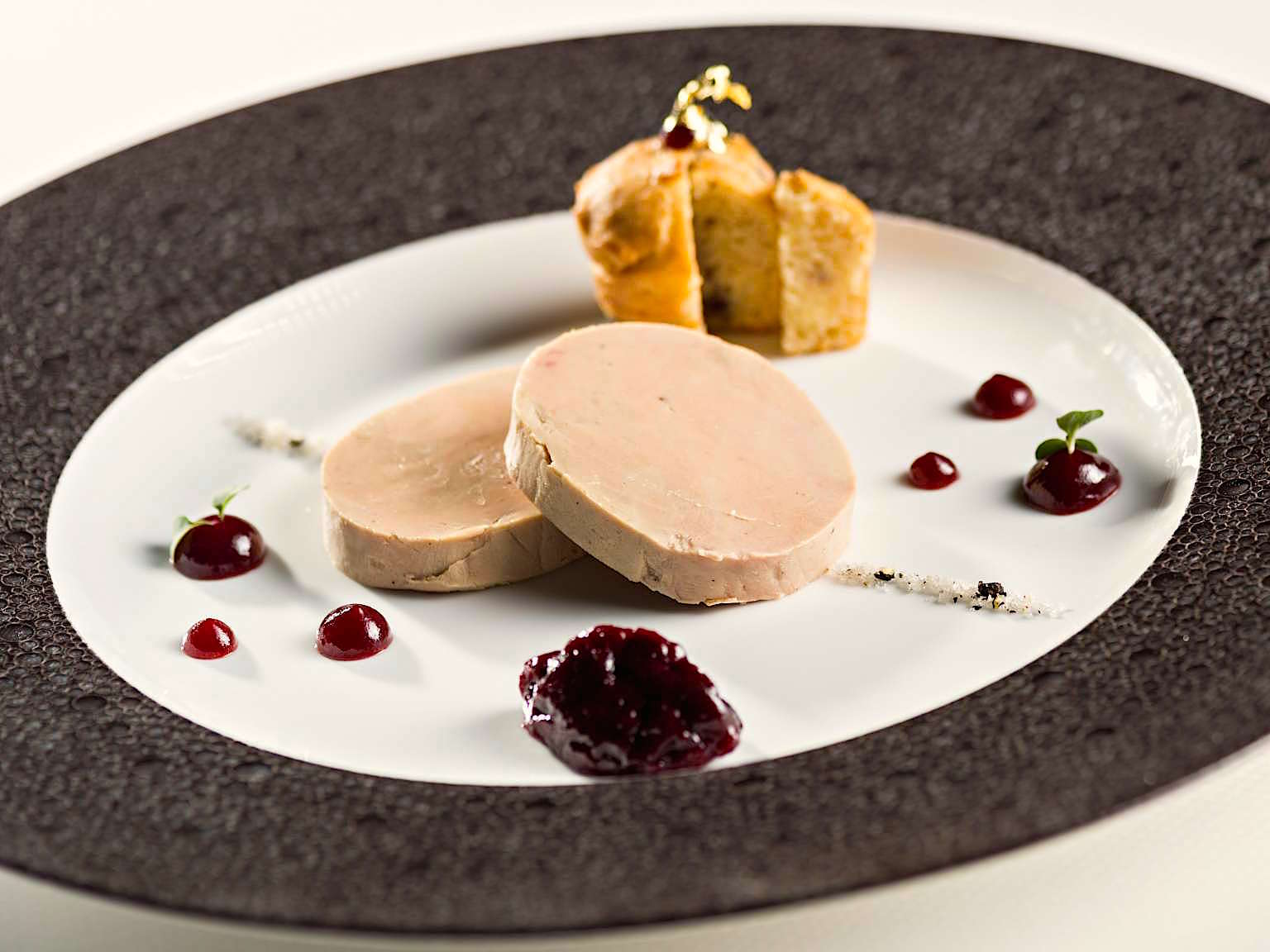
Being no stranger to Michelin-starred
establishments, we left our meal here scratching our
head. If this place doesn't merit at least one star,
then something is amiss in the world's once
respected food guide. Regardless, if this is what
no-star cuisine tastes like in France, then we could
die happy eating nothing but. Bully for you,
Monsieur Bohrer! Stay the course and keep on
cooking, and we'll keep on coming to Strasbourg.
Part Two will
appear next week.
❖❖❖
By John Mariani
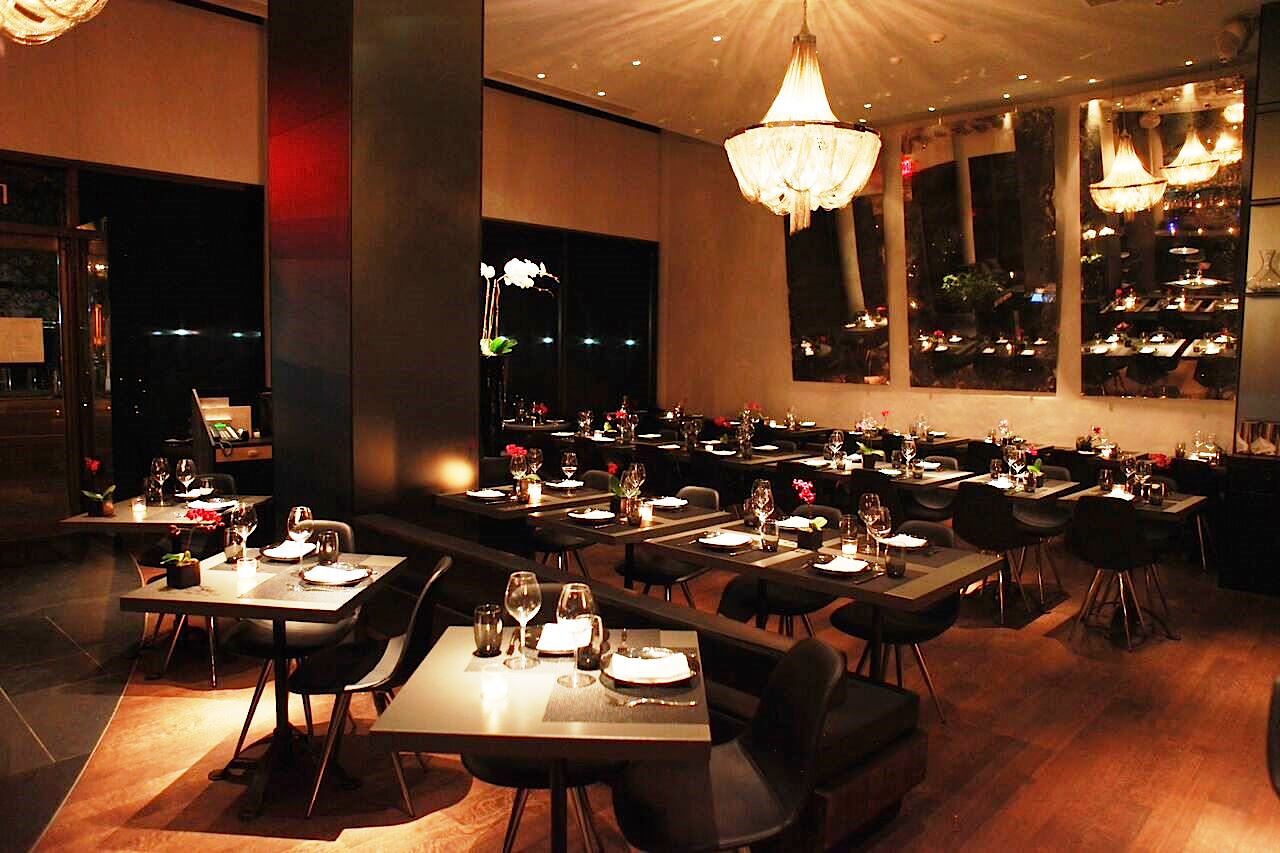 THEO'S
THEO'S
1048 Third
Avenue (corner of
East 62nd Street)
917-475-1721
theosny.com
Just three months old, and despite one change
of chef and a re-casting of the menu, Theo’s has
emerged as one of the best seafood restaurants in
Manhattan. That
it is owned by a good-looking 21-year-old Greek
named Theo Katsihtis (his father is in the upscale
café business) makes it all the more remarkable
and lends the spacious, swanky restaurant a
youthful vibe, which includes a DJ later in the
evening. The
interactive open kitchen (with a few counter seats
for a tasting menu each night) adds light and some
dramatic cooking pyrotechnics. The waitstaff is
fleet-footed and very attentive, as is Theo
himself, who visits all the tables to make sure
all goes well.
The high ceilings, shades of gray and silver
(despite what the photo above shows), antique
acid-etched mirrors, slate-topped bar and tables set
with tulips and votive candles make a stylish,
comfortable ambiance, perhaps a bit more like Las
Vegas than the East Side of Manhattan. Of course,
there is the requisite long list of “signature”
cocktails ($14), and the adequate wine list has a
number of bottlings at decent prices that go with
the kind of food served.
While Theo’s is described as a “Mediterranean
restaurant,” the menu now includes a number of meat
dishes that don’t quite fit that description. But,
by sticking with the seafood, you will have no doubt
that Theo and Chef Nicholas Poulmentis are trying to
stay true to their commitment to seafood, from the
array of East and West Coast oysters (market price),
glistening in a splendid presentation, to a Spanish
brown turbot, a species that almost never shows well
in transport across the Atlantic but that here is as
fine an example as I’ve had in NYC. 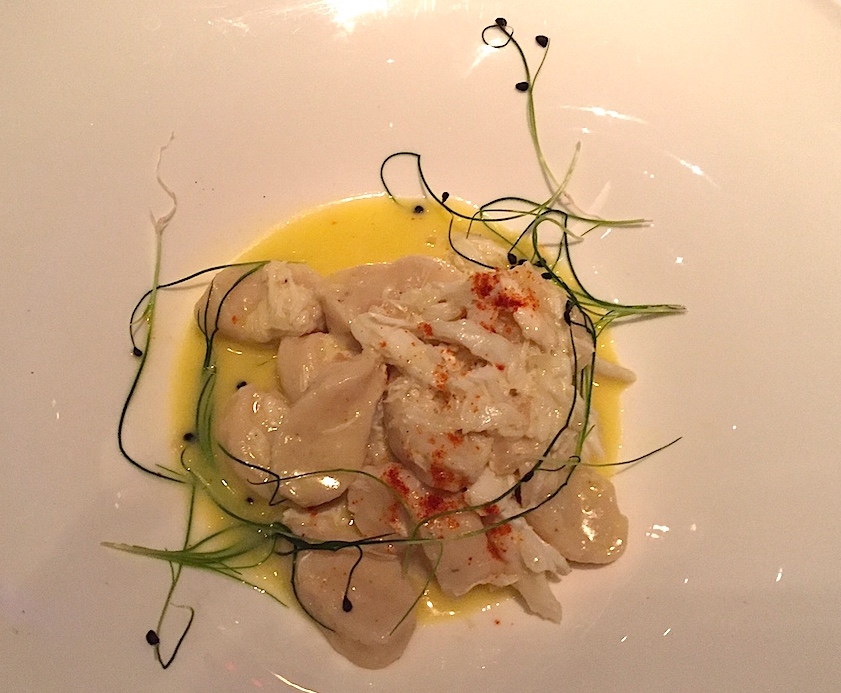
Poulmentis,
from the island of Kythria, had been Executive Chef
at Kellari Taverna, and the TV show “Greek Kitchen,”
so you know where his heart lies.
You’ll receive small popovers
instead of bread; unfortunately, ours came dried
out, with no butter on the table.
To
begin, my party enjoyed a lovely carpaccio of
octopus dotted with caviar, and skewered grilled
shrimp that had a good briny flavor to them. Light,
generously proportioned lobster and citrus salad
came with creamy avocado, frisée, fines herbs and
red leaf sorrel ($22). We had a choice that evening
of either Manhattan or New England clam chowder
($17), and I thought the latter would be a better
test of the chef’s talents. I was
rewarded with a textbook version of what New England
chowder should be: creamy but not thick, seasoned
but not over-spiced, with the right amount and size
of tender clams with diced purple potato, bacon,
celery leaf and purple shiso.
Equally impressive was a pretty dish of crab and
ricotta gnocchi
($24), al
dente as they should be, with a touch of aji amarillo
pepper, basil and a little paprika for color.
I have already mentioned the fine turbot, whose
excellence was clearly due to its freshness; it was
a special, indicating it was the day’s catch, not
always on the menu. A tuna steak ($28) was nicely
cooked and rendered but lacked fatty flavor and
richness.
But a Dover sole (left) revealed
just how delicate a difference there is between a
too-meaty, overcooked example and the tender, juicy,
buttery one at Theo’s, where all the plates are
heated to keep the food warm, essential for a fish
like sole that is best filleted at the table. I prefer
to perform that function by myself, and the kitchen
smartly removed the boney edges, which facilitated
the flesh to come off the spine with ease. I haven’t
had Dover sole this good in this country in quite
some time. Also,
at $48 it was a bargain by comparison with what you
may pay elsewhere in NYC.
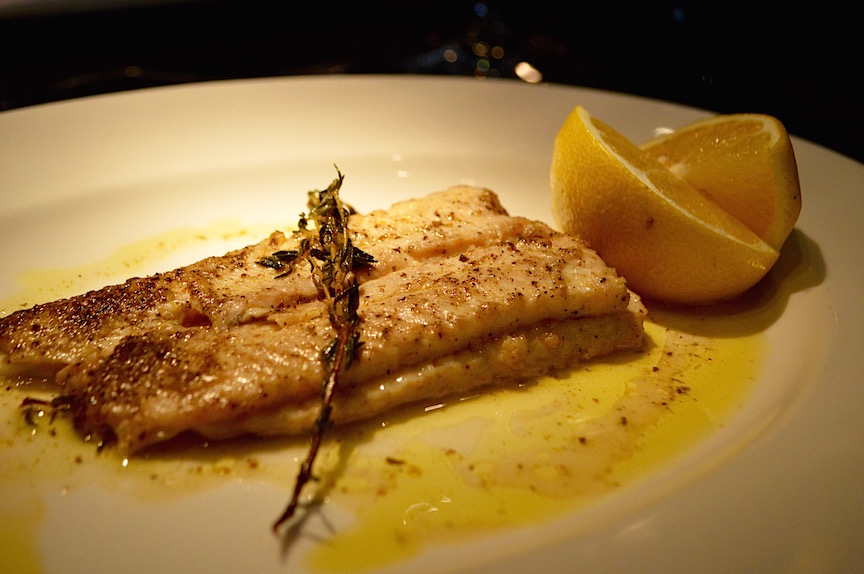 Prices
for meat dishes at Theo’s can be very high, however,
almost as if they’d prefer you didn’t order them.
And it is a shame, given the high quality of the
rest of the ingredients on the menu and given his
Greek background, that Katsihtis is serving inferior
Australian lamb.
Prices
for meat dishes at Theo’s can be very high, however,
almost as if they’d prefer you didn’t order them.
And it is a shame, given the high quality of the
rest of the ingredients on the menu and given his
Greek background, that Katsihtis is serving inferior
Australian lamb.
But
even the French fries ($9) were close to the way
they make frites
in Europe, triple fried and cooked through, golden
brown and crisp outside. Brussels sprouts ($9) were
all right but nothing special, as if the chef felt
he had to have them on the menu without really
wanting to.
Desserts
($11-$14) were far from the usual:
rosewater-flavored panna cotta;
avocado semi-freddo
with cream caramel and crushed pistachios; and
gold-foil brushed chocolate cake with layers of
chocolate soufflé and vanilla semi-freddo;
and an English pie called banofee, with caramelized
bananas and a waffle cup.
My friends and I were gone before
Theo’s got into its post-nine p.m. swing, but while
we were there, the noise level was wholly conducive
to good conversation, and it’s worthwhile to have
one with Theo himself. Within seconds you’ll sense
how proud he is of what he’s trying to accomplish
here, and his youthful exuberance is as fetching as
the conviviality of a night at Theo’s.
Theo’s is open for
dinner seven nights a week; Lunch is served
Mon.-Fri. ; brunch Sat. & Sun.
LUCK BE A
LOBSTER TONIGHT
 FOOD WRITING
101:
FOOD WRITING
101:
NEVER EVER EVER BEGIN
AN ARTICLE WITH “HONESTLY.”
“Honestly, I didn’t think our
Mediterranean vacation could get much better.”
—Patrick Scott, "Adventure Travel Takes the Plunge,” NY Times
(2/14/16).
Any of John Mariani's books below may be ordered from amazon.com.
 I'm proud and happy to announce that my
new book, The Hound
in Heaven (21st Century Lion Books), has just
been published through Amazon and Kindle.
I'm proud and happy to announce that my
new book, The Hound
in Heaven (21st Century Lion Books), has just
been published through Amazon and Kindle. It is a novella, and for anyone who loves dogs, Christmas, romance, inspiration, even the supernatural, I hope you'll find this to be a treasured favorite. The story concerns how, after a New England teacher, his wife and their two daughters adopt a stray puppy found in their barn in northern Maine, their lives seem full of promise. But when tragedy strikes, their wonderful dog Lazarus and the spirit of Christmas are the only things that may bring back his master back from the edge of despair.
WATCH THE VIDEO!
“What a huge surprise turn this story took! I was completely stunned! I truly enjoyed this book and its message.” – Actress Ali MacGraw
“He had me at Page One. The amount of heart, human insight, soul searching, and deft literary strength that John Mariani pours into this airtight novella is vertigo-inducing. Perhaps ‘wow’ would be the best comment.” – James Dalessandro, author of Bohemian Heart and 1906.
“John Mariani’s Hound in Heaven starts with a well-painted portrayal of an American family, along with the requisite dog. A surprise event flips the action of the novel and captures us for a voyage leading to a hopeful and heart-warming message. A page turning, one sitting read, it’s the perfect antidote for the winter and promotion of holiday celebration.” – Ann Pearlman, author of The Christmas Cookie Club and A Gift for my Sister.
“John Mariani’s concise, achingly beautiful novella pulls a literary rabbit out of a hat – a mash-up of the cosmic and the intimate, the tragic and the heart-warming – a Christmas tale for all ages, and all faiths. Read it to your children, read it to yourself… but read it. Early and often. Highly recommended.” – Jay Bonansinga, New York Times bestselling author of Pinkerton’s War, The Sinking of The Eastland, and The Walking Dead: The Road To Woodbury.
“Amazing things happen when you open your heart to an animal. The Hound in Heaven delivers a powerful story of healing that is forged in the spiritual relationship between a man and his best friend. The book brings a message of hope that can enrich our images of family, love, and loss.” – Dr. Barbara Royal, author of The Royal Treatment.
 |
The Encyclopedia of American Food and Drink by John F. Mariani (Bloomsbury USA, $35) Modesty forbids me to praise my own new book, but let me proudly say that it is an extensive revision of the 4th edition that appeared more than a decade ago, before locavores, molecular cuisine, modernist cuisine, the Food Network and so much more, now included. Word origins have been completely updated, as have per capita consumption and production stats. Most important, for the first time since publication in the 1980s, the book includes more than 100 biographies of Americans who have changed the way we cook, eat and drink -- from Fannie Farmer and Julia Child to Robert Mondavi and Thomas Keller. "This book is amazing! It has entries for everything from `abalone' to `zwieback,' plus more than 500 recipes for classic American dishes and drinks."--Devra First, The Boston Globe. "Much needed in any kitchen library."--Bon Appetit. |
"Eating Italian will never be the same after reading John Mariani's entertaining and savory gastronomical history of the cuisine of Italy and how it won over appetites worldwide. . . . This book is such a tasteful narrative that it will literally make you hungry for Italian food and arouse your appetite for gastronomical history."--Don Oldenburg, USA Today. "Italian
restaurants--some good, some glitzy--far
outnumber their French rivals. Many of
these establishments are zestfully described
in How Italian Food Conquered the World, an
entertaining and fact-filled chronicle by
food-and-wine correspondent John F.
Mariani."--Aram Bakshian Jr., Wall Street
Journal.
"Equal parts
history, sociology, gastronomy, and just
plain fun, How Italian Food Conquered the
World tells the captivating and delicious
story of the (let's face it) everybody's
favorite cuisine with clarity, verve and
more than one surprise."--Colman Andrews,
editorial director of The Daily
Meal.com. "A fantastic and fascinating
read, covering everything from the influence
of Venice's spice trade to the impact of
Italian immigrants in America and the
evolution of alta cucina. This book will
serve as a terrific resource to anyone
interested in the real story of Italian
food."--Mary Ann Esposito, host of PBS-TV's
Ciao
Italia. "John Mariani has written the
definitive history of how Italians won their
way into our hearts, minds, and
stomachs. It's a story of pleasure over
pomp and taste over technique."--Danny Meyer,
owner of NYC restaurants Union Square
Cafe, The Modern, and Maialino.
|
 |
 |
 |
 |
 |
 |
 |
 |
 Everett Potter's Travel Report:
Everett Potter's Travel Report: 
 Eating Las Vegas
JOHN CURTAS has been covering the Las Vegas
food and restaurant scene since 1995. He is
the co-author of EATING LAS VEGAS – The 50
Essential Restaurants (the fourth
edition of which will be published in early
2016), as well as the author of the Eating Las
Vegas web site: www.eatinglasvegas.
He can also be seen every Friday morning as
the “resident foodie” for Wake Up With the
Wagners on KSNV TV (NBC) Channel 3 in
Las Vegas.
Eating Las Vegas
JOHN CURTAS has been covering the Las Vegas
food and restaurant scene since 1995. He is
the co-author of EATING LAS VEGAS – The 50
Essential Restaurants (the fourth
edition of which will be published in early
2016), as well as the author of the Eating Las
Vegas web site: www.eatinglasvegas.
He can also be seen every Friday morning as
the “resident foodie” for Wake Up With the
Wagners on KSNV TV (NBC) Channel 3 in
Las Vegas.

MARIANI'S VIRTUAL GOURMET
NEWSLETTER is published weekly. Editor/Publisher: John
Mariani.
Editor: Walter Bagley. Contributing Writers: Christopher Mariani,
Robert Mariani, Misha
Mariani,
John A. Curtas, Edward Brivio, Mort Hochstein,
Andrew Chalk, Dotty Griffith and Brian Freedman. Contributing
Photographers: Galina Dargery, Bobby
Pirillo. Technical Advisor: Gerry McLoughlin.
To un-subscribe from this newsletter,click here.
© copyright John Mariani 2016

